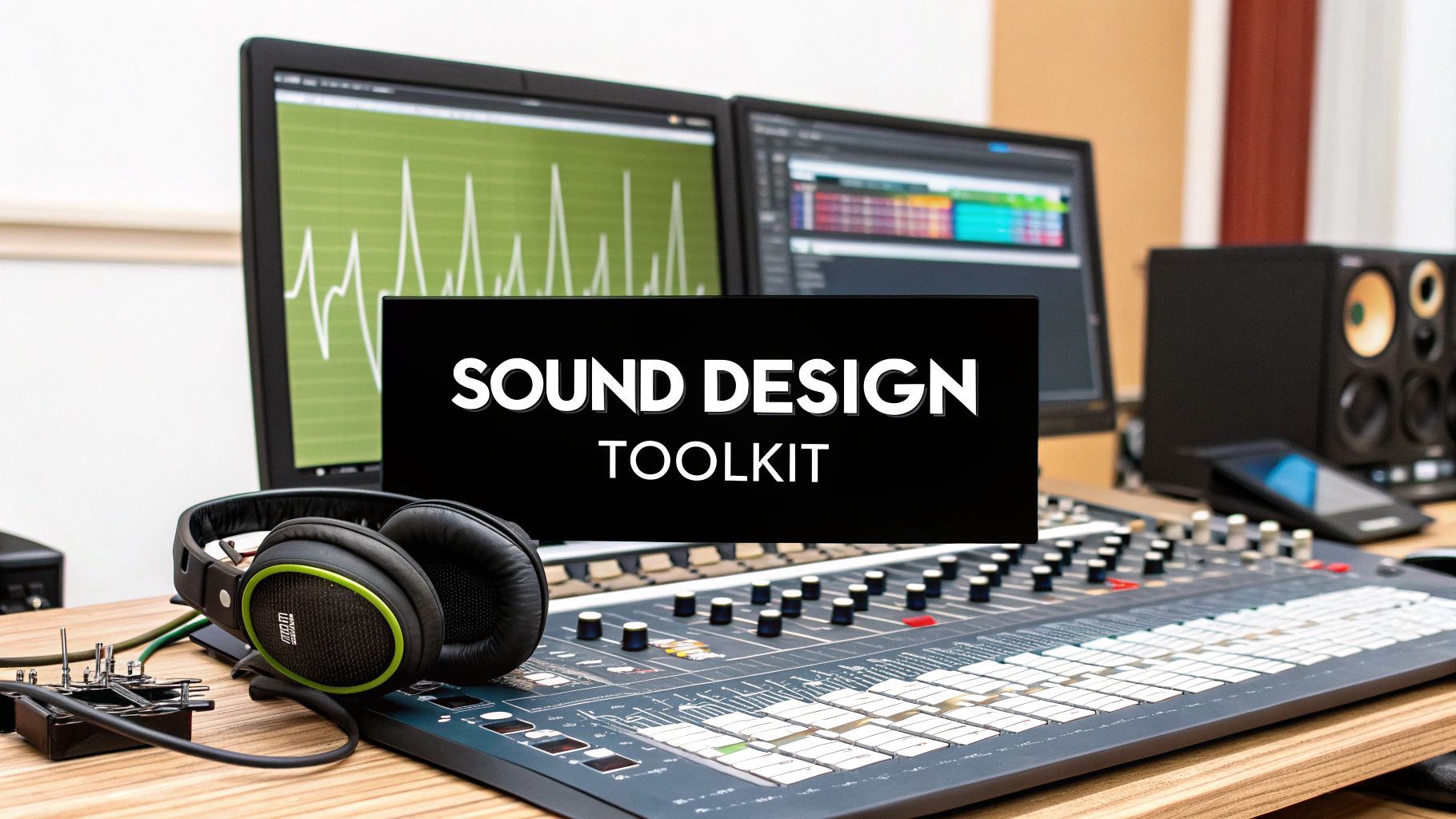
Think of sound design software as a digital playground for anyone who works with audio. It’s the collection of tools we use to sculpt, create, and organize every sound you hear in movies, video games, podcasts, and even your favorite apps.
It’s less of a single program and more of a complete workshop—a sonic artist's studio where raw audio gets molded into an experience that pulls you in.
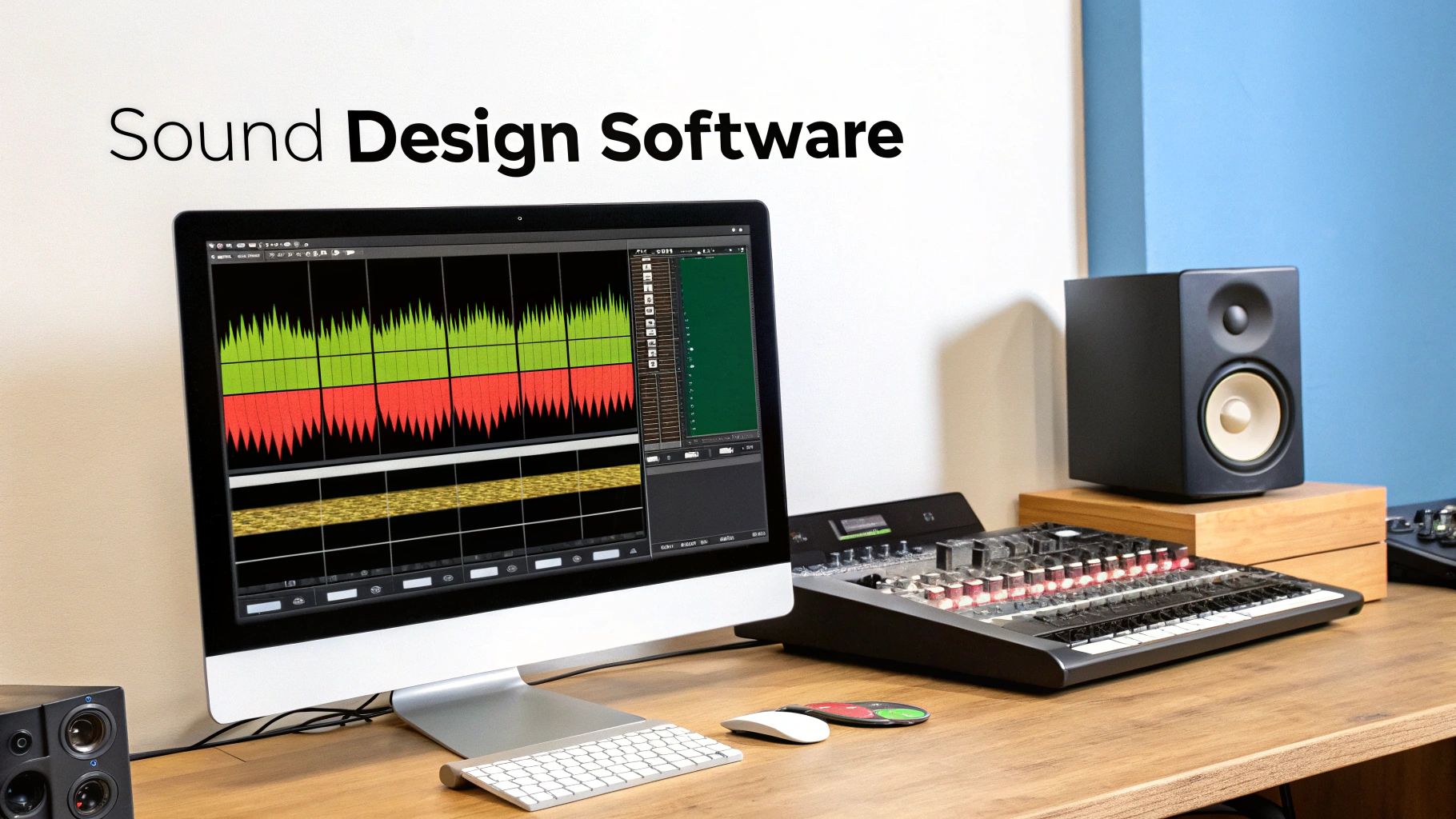
Let's cut through the jargon. At its core, sound design software is the creative engine that brings auditory worlds to life. It’s what sound designers use to build everything from the ground-shaking roar of a monster to the satisfying swoosh of sending an email.
A good analogy is a chef's kitchen. You have your knives for chopping (editing), mixers for blending (layering), and ovens for finishing (mastering). A sound designer uses their software in much the same way—chopping up recordings, blending different elements, and “baking” them into a final, polished sound. This isn't just one application but a whole ecosystem of specialized tools.
Fundamentally, this software gives us the power to bend sound waves to our will. We can layer dozens of recordings to build a complex, textured atmosphere, or we can conjure entirely new sounds out of thin air using synthesis. The ultimate goal is always to make the listener feel something—to tell a story, create a mood, or give a user important feedback.
That bone-chilling creak of a door in a horror movie? That wasn't just a lucky recording. It was probably designed, layered, and processed with sound design software to maximize the tension and make you jump.
"I was introduced to Sound Particles when I was working on The Walking Dead and was completely blown away by it... I was blown away by how natural and real everything sounded." - Tim Farrell, Sound Effects Editor
In a world saturated with content, great audio isn't a luxury; it's a requirement. It’s the invisible glue that makes a video game feel real, a movie feel immersive, or an app feel intuitive. Without these tools, crafting those rich sonic landscapes just wouldn't be possible.
The key functions boil down to a few core tasks:
This guide will pull back the curtain on these essential tools. We’ll explore the different types of software out there and show you how they all fit together in a real-world professional workflow.
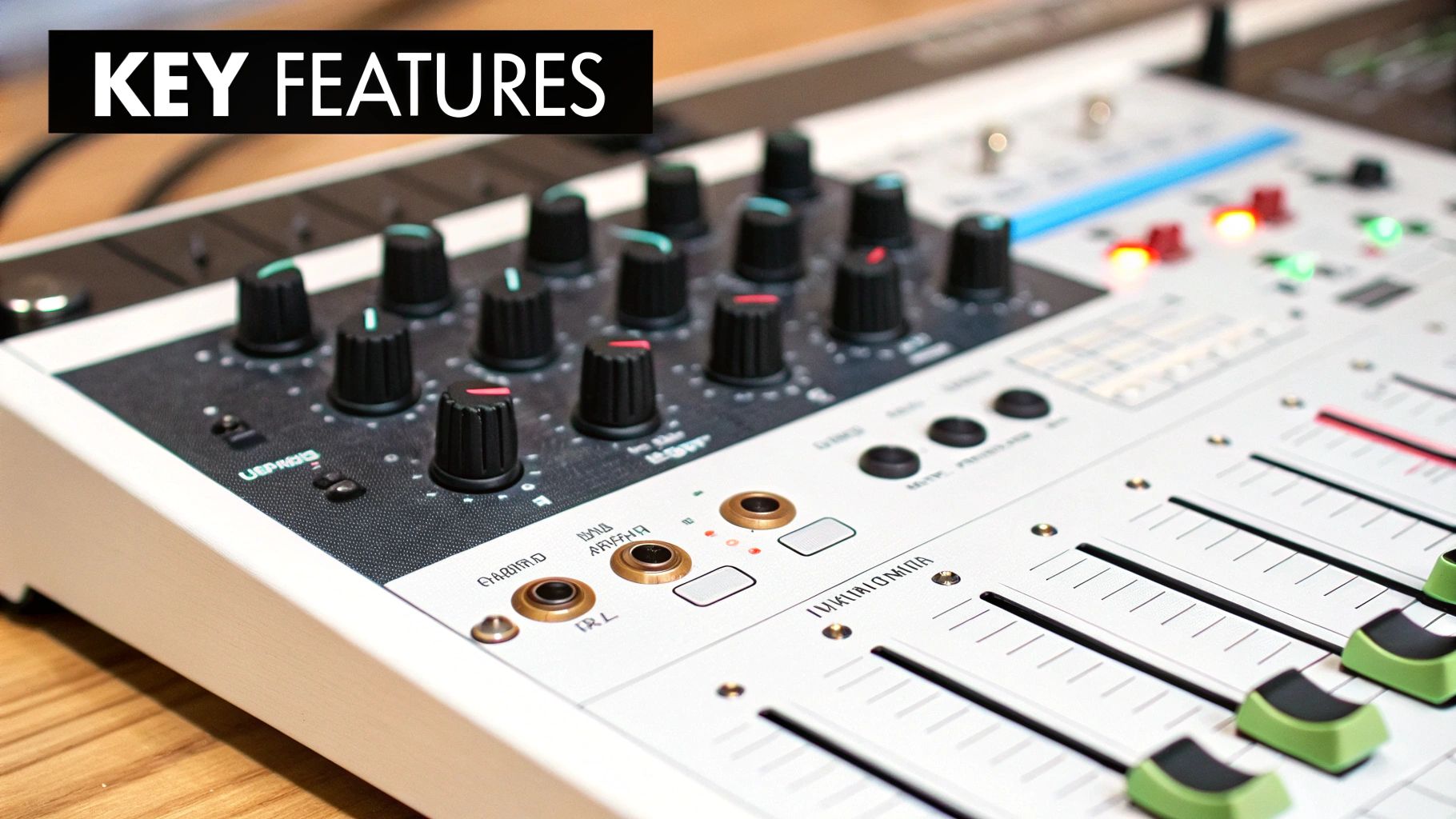
Every sound designer’s setup, whether it’s a humble bedroom studio or a sprawling Hollywood post-production suite, is built around a few essential components that have to work together. It's less like a simple list of programs and more like a painter's studio—a space where every tool has a distinct, yet collaborative, purpose.
The three pillars of any audio toolkit are the Digital Audio Workstation (DAW), plugins, and sound libraries. Each one handles a specific part of the job, and the way they interact is what makes professional sound design software so powerful. Let's pull back the curtain on how these pieces fit together.
The Digital Audio Workstation (DAW) is the absolute heart of your workflow. If we're sticking with the painter analogy, the DAW is both the canvas and the easel. It's the space where you arrange, edit, and mix every single audio element. It gives you the timeline, the tracks, and the organizational power to build a sonic world from scratch.
Whether you're layering the hundred different sounds of a bustling city street or carefully placing the subtle audio cues in an emotional film scene, it all happens inside the DAW. It’s the command center. The global DAW market, valued at USD 4.1 billion in 2024 and projected to hit USD 6.65 billion by 2030, shows just how central these platforms are to modern media.
Picking the right DAW is a huge first step, as it really defines your creative environment. For a deeper dive, check out our guide comparing popular Digital Audio Workstations to see what might work for you.
So, if the DAW is your canvas, then plugins are your collection of specialized brushes, paints, and texturing tools. These are smaller programs that "plug in" to your DAW to do specific jobs that the main application might not handle on its own. They are what you use to add color, shape, and personality to your raw sounds.
Plugins generally fall into a couple of key categories:
A plugin isn’t just a technical tool; it's a creative decision. The right reverb can make a simple footstep sound lonely and distant, while a distortion plugin can turn a soft hum into an aggressive, menacing roar.
This modular setup means you can build a toolkit perfectly suited to your niche. A game audio designer might collect plugins for crafting monster growls and sci-fi weapon blasts, while a film mixer focuses on tools for cleaning up dialogue and creating hyper-realistic ambiences.
Finally, we have sound libraries. These are your raw materials—a massive, organized palette of pre-recorded audio files. We’re talking about everything from lion roars and crashing waves to futuristic spaceship hums and the subtle tone of an empty room.
Instead of having to go out and record every single sound yourself, you can pull from these libraries to find the perfect building blocks. Need the sound of a medieval battle? A good library will have thousands of individual sword clashes, armor clanks, and arrow whooshes ready to go.
These three elements—the DAW, plugins, and sound libraries—form a dynamic, interconnected ecosystem. The DAW provides the structure, the sound libraries offer the raw content, and the plugins give you the creative power to transform it all into a finished, compelling piece of audio art.
Stepping into the world of audio software can feel like walking into a massive hardware store, with aisles of shiny tools stretching to the ceiling. With so many options, how do you know which one is right for the job? It all comes down to breaking them into a few key categories, each designed for a specific purpose.
Getting a handle on these categories helps you build a versatile toolkit. One project might demand an all-in-one production hub, while the next requires a surgical repair tool. Let's walk through the main types of sound design software to help you match the right tool to your creative goals.
First up is the Digital Audio Workstation (DAW). We've already touched on this, but it’s worth repeating: this is the central canvas of your workflow. Think of a DAW as the ultimate multi-tool—it can record, edit, mix, and arrange audio all in one place. It’s the foundational piece of software where everything else, from plugins to sound libraries, comes together.
For example, a game audio designer might use a DAW like Reaper or Pro Tools to layer dozens of individual sound effects for a single cinematic explosion. They’ll meticulously arrange the initial boom, the crackle of fire, the tinkle of falling debris, and a deep, low-frequency rumble, all on separate tracks. This is where the magic happens.
Here’s a quick look at how different DAWs stack up, which gives you a good feel for the landscape.
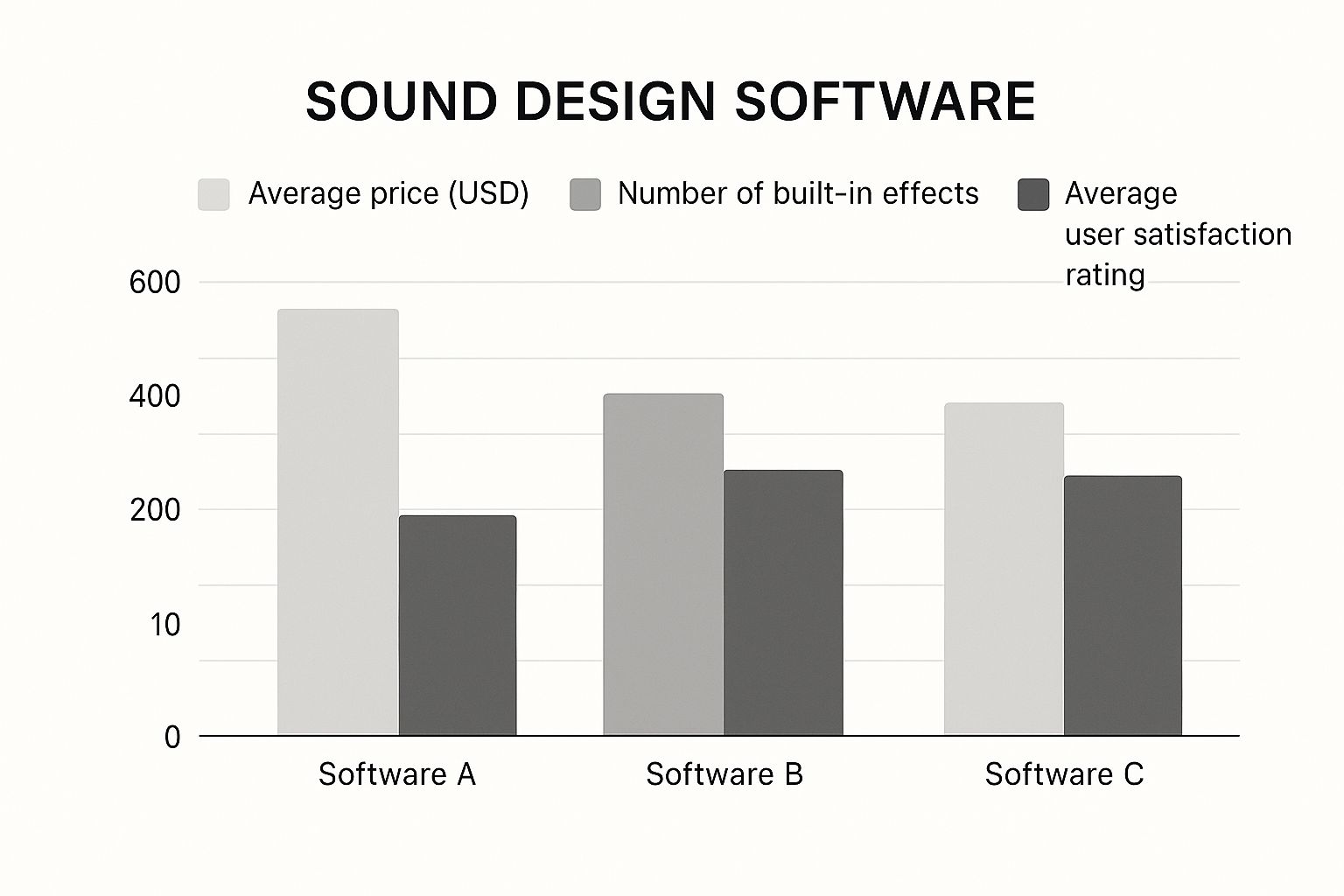
As you can see, some tools are packed with built-in effects, while others might be more wallet-friendly. It really just reflects the different needs of audio creators out there.
To make things a bit clearer, let's look at how these different software types stack up against each other.
| Software Category | Primary Function | Best For | Example Tools |
|---|---|---|---|
| DAW | All-in-one audio recording, editing, mixing, and arrangement. | Complex multi-track projects, music production, and post-production. | Pro Tools, Reaper, Ableton Live |
| Specialized Editor | High-precision, single-task audio manipulation. | Audio repair, noise removal, batch processing, and mastering. | iZotope RX, Adobe Audition |
| Synthesizer | Creating new sounds from scratch using electronic generation. | Designing unique electronic textures, soundscapes, and musical tones. | Serum, Massive, Vital |
| Sampler | Manipulating and repurposing pre-existing audio recordings. | Transforming real-world sounds into instruments or new effects. | Native Instruments Kontakt, Ableton Sampler |
This table shows how each category fills a specific niche in a sound designer's workflow, from the broad strokes of a DAW to the fine-tipped pen of a specialized editor.
While a DAW is a fantastic jack-of-all-trades, sometimes you need a specialist. That’s where specialized audio editors come in. These tools are built for one specific, high-precision task, and they do it incredibly well. The most common example is audio repair software, designed to surgically remove unwanted noise from a recording.
Imagine you’ve captured the perfect line of dialogue, but a dog barks right in the middle of it. A specialized editor like iZotope RX lets you visually identify the bark's frequency and literally erase it without mangling the actor's voice. It’s like performing sonic surgery with a digital scalpel.
These focused tools aren't meant to replace your DAW. Instead, they work alongside it, providing powerful solutions for problems that require extreme detail and accuracy.
Other editors might focus on things like batch processing thousands of files at once—a huge time-saver in game development—or mastering audio to meet the specific loudness standards for Spotify or YouTube.
Next, we have synthesizers, or "synths." These are basically instruments that create sound electronically from the ground up. Instead of tweaking an existing recording, you're generating brand new audio, giving you absolute control over its character, pitch, and texture.
Think of a synth as a block of digital clay. You start with a basic waveform—a smooth sine wave or a harsh sawtooth wave—and use a few core components to sculpt it into something entirely new. This is how sound designers conjure up otherworldly sci-fi sounds, futuristic UI clicks, and chest-thumping bass drones you just can't find in the real world.
A great example is Serum by Xfer Records, which you’ll find in the toolkits of producers creating everything from lush atmospheric pads to aggressive, metallic impacts.
Finally, let’s talk about samplers. Where a synthesizer creates sound from nothing, a sampler starts with a pre-existing audio recording (a "sample") and gives you the tools to twist, bend, and reshape it. That sample could be anything: a single drum hit, a line of dialogue, or a snippet from an old orchestral record.
Samplers let you pitch the audio up or down, chop it into tiny pieces, loop it, reverse it, and run it through all sorts of creative effects. For instance, you could take a recording of a breaking glass bottle, load it into a sampler, and turn it into a weird, percussive, melodic instrument.
This ability to repurpose and re-contextualize sound makes samplers an incredibly fun and powerful part of any sound design software collection. They beautifully bridge the gap between recording real-world audio and creating entirely new sonic identities.
Theory is one thing, but seeing how these tools—the DAW, plugins, and sound libraries—fit together in practice is where it all clicks. Let's walk through a real-world scenario.
Imagine you're handed a ten-second animated clip. It's a simple scene: a futuristic vehicle glides to a stop in a rainy, neon-drenched city, and its doors hiss open. Your job is to breathe life into this silent world, making it feel immersive and completely believable. This isn't just about dropping in a few random sounds; it's a methodical process, a structured workflow with clear stages.
Every project starts with a plan. Before you even think about touching a microphone or opening your software, you have to dig into the creative brief and the animation itself. What’s the vibe here? Are we in a gritty, dystopian future or a sleek, optimistic one? The answers to these questions will shape every sound you choose.
For our scene, let's say the director wants a feeling of advanced but slightly gritty technology against a moody, rain-soaked backdrop. You'd start by breaking down the scene and making a "shopping list" of core audio elements:
This initial brainstorming turns visual cues and story goals into a concrete audio blueprint.
With your blueprint ready, it's time to gather the raw materials. In the acquisition phase, you either head out to record custom sounds (known as Foley) or dive into your massive sound libraries. Most projects, including this one, call for a bit of both.
You might get creative and record the piercing blast from a steam iron for that door hiss or tap on a metal toolbox for some of the vehicle's interior clicks. But for the broader ambient sounds, like the rain and city hum, digging through a high-quality sound library is way more efficient. You'd look for several different rain recordings—a heavy downpour, a light drizzle, drops hitting a metal awning—to create a rich, textured foundation.
The goal here isn't to find one perfect sound. It's to collect a palette of high-quality, raw audio building blocks. The real magic happens when you start layering and twisting these elements in the next stage.
Now, we step into the digital workshop: the Digital Audio Workstation (DAW). This is where you import all those raw audio files, dropping them onto different tracks in the timeline. The manipulation stage is where technical skill and pure artistry collide.
First, you'd build the ambient bed. The different rain recordings get blended together. You might use a low-pass filter plugin to gently roll off the high frequencies of the city sounds, pushing them into the background to create a sense of distance and mood.
Next up is the vehicle's hover sound. You could build this by combining a low-frequency synth drone with a recording of an electrical transformer buzzing away. Using an equalizer (EQ) plugin, you carve out specific frequencies for each sound so they sit together nicely without turning into a muddy mess. You might even add a creative plugin to give the hum a subtle, rhythmic pulse, making it feel active. For the door, you'd layer that steam iron recording with a quick burst of white noise, then use a compressor to make the initial "hiss" really sharp and impactful.
The final stretch is finalization, which is all about mixing and mastering. You have all your layers, but now they need to be balanced into a cohesive whole. This means carefully adjusting the volume levels of every single track—the rain needs to set the mood without overpowering the main action of the vehicle.
You might add a touch of a reverb plugin to all the sounds, which helps place them in the same "acoustic space" and tricks the ear into believing the vehicle is actually in that rainy city. Finally, a little compression and limiting on the master track glues everything together and brings the overall volume to a consistent, professional level, ready for delivery.
This whole journey, from that first creative spark to the final file, is the essence of the audio post-production workflow. To see this process broken down even further, check out our complete guide to the audio post-production workflow.
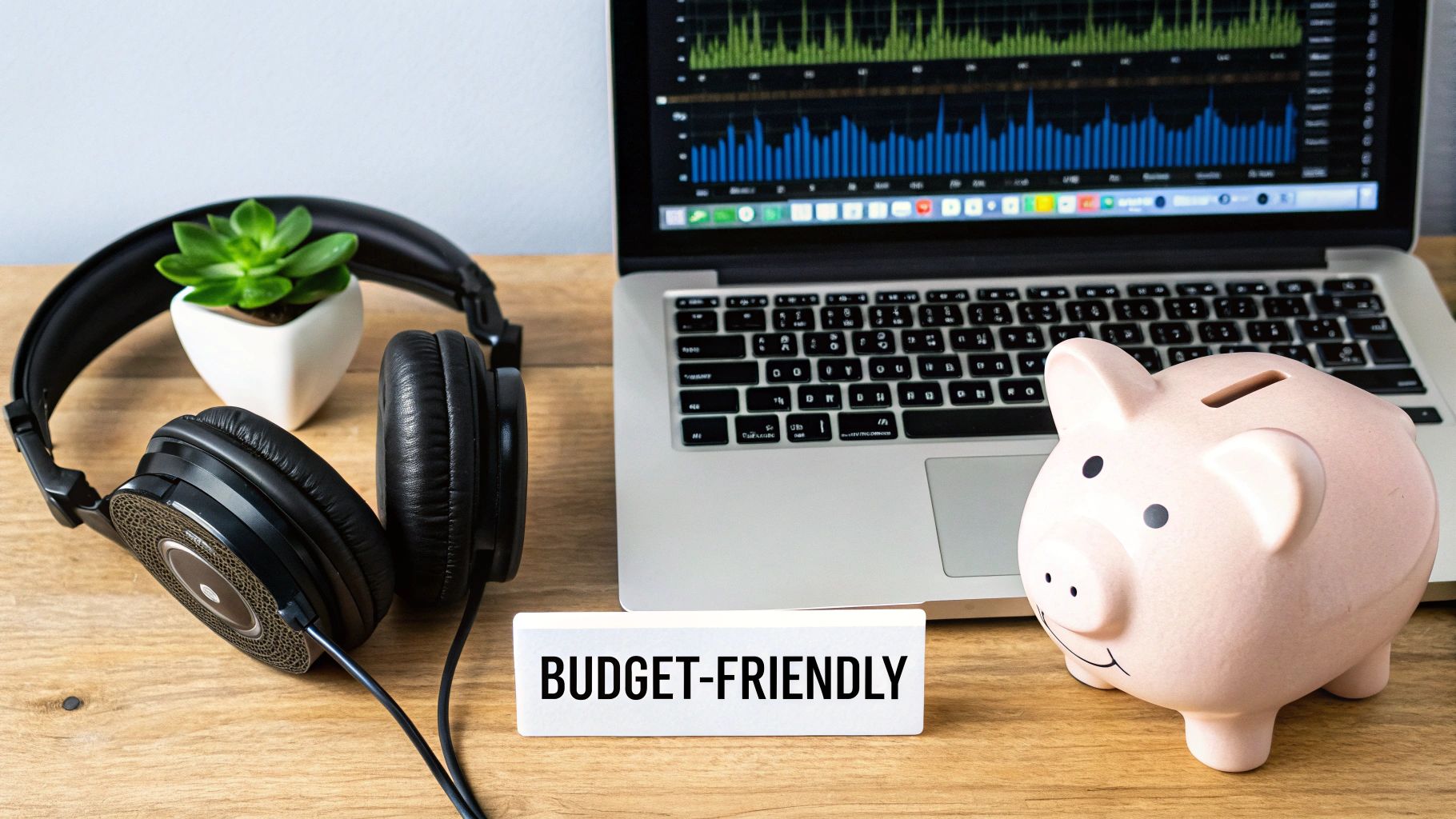
Artificial intelligence has moved from science fiction into the studio, becoming a real creative partner for sound designers. AI isn't here to replace the artist; it’s more like a powerful assistant that takes over the grunt work and opens up creative avenues we're only just beginning to explore.
This shift is making our sound design software smarter and way more intuitive. Imagine having a highly skilled apprentice who can instantly clean up noisy dialogue, suggest the perfect EQ curve, or spit out a hundred variations of a footstep while you focus on the bigger creative vision.
Let's be honest, a huge chunk of sound design has always been technical and repetitive. We've all spent countless hours manually cleaning up background hum, de-clicking dialogue, or trying to isolate a specific sound from a messy recording. It’s a necessary evil.
AI-powered tools are now doing that heavy lifting with incredible precision, and they do it in a fraction of the time. The tech is smart enough to listen to an audio file, figure out what's noise and what's the good stuff, and then surgically remove the junk. This frees you up to spend less time being a technician and more time being an artist.
By handling the meticulous, non-creative work, AI acts as a workflow accelerator. It allows designers to stay in their creative flow state for longer, leading to better and more imaginative results without the burnout of manual labor.
Beyond just cleaning up audio, AI is fundamentally changing how we create sounds from scratch. The real game-changer here is generative audio. These tools can dream up entirely new sound effects based on nothing more than a simple text description.
Picture this: you need the sound of "a rusty metal gate slowly creaking open in a windy, abandoned cavern." Instead of spending the next hour digging through your sound libraries or setting up a Foley session, you can just type that prompt into a generative AI and get a custom, royalty-free sound effect in seconds. The level of specificity and speed is something we couldn't have dreamed of a few years ago.
Platforms like SFX Engine are leading the charge here, giving creators tools to generate sounds with just a few words. This doesn't just make things faster; it makes it possible to create audio that was previously impossible or impractical to produce. To see just how this works, check out our guide on how to create sounds using AI.
This wave of AI is a huge reason why the audio industry is booming. In 2024, the global sound effects software market was valued at USD 3.5 billion, and it’s on track to hit USD 7.1 billion by 2033. A lot of that growth is coming from AI-driven tools that are making professional-grade capabilities available to everyone, from indie creators to massive Hollywood studios. You can find more details about this market growth on datahorizzonresearch.com.
Ultimately, AI isn't a threat to our creativity—it's an amplifier for it. By taking the most laborious parts of the process off our plates and making powerful tools more accessible, AI is empowering a new generation of designers to build richer, more immersive sonic worlds than ever before.
Picking the right sound design software feels a lot like a musician choosing an instrument. The one you pick shapes how you create, what you can make, and how quickly you can bring your ideas to life. And with so many options out there, it’s easy to get overwhelmed. But it doesn’t have to be.
The secret is to ignore the noise and focus on what really matters: your goals, your budget, and where you are on your creative journey. Are you just starting out and looking to experiment, or are you a pro who needs tools that can handle a heavy workload? Answering that question is the first step.
Before you even look at a single piece of software, get specific about your projects. A film sound designer has a completely different workflow than a game audio artist, and their toolkits reflect that.
Once you know your primary focus, you’ve already cut the list of potential tools in half.
Next up, a reality check. There's no point in buying a super-complex piece of software if you're just starting out. You'll just get frustrated.
The best software isn't the one with the most features—it's the one you'll actually open and enjoy using. A simple, intuitive tool is always better than a complicated one that just collects dust.
This is why free trials are your best friend. Never buy software without test-driving it first. A hands-on trial is the only way to know if a program’s workflow feels right to you. You can even learn the basics on free tools like Audacity or GarageBand before deciding to invest in a professional-grade setup.
The market for these tools is booming. Valued at roughly USD 1.2 billion in 2025, the global sound design software market is expected to skyrocket to USD 2.2 billion by 2033. This incredible growth means more competition and better options for creators at every budget. You can dig deeper into these industry trends on archivemarketresearch.com.
Diving into sound design software for the first time can feel like learning a new language. Let's clear up some of the most common questions you might have.
When you're just starting, the goal is to find a Digital Audio Workstation (DAW) that gets out of your way and lets you learn. You don't need all the bells and whistles just yet.
Free tools like GarageBand (for Mac users) or Audacity are perfect for this. They let you get your hands dirty with the fundamentals—editing, layering, and simple effects—without costing you a penny.
If you're ready to dip your toe into professional software, check out Reaper. It's a full-powered DAW with an incredibly generous trial, giving you plenty of time to find your footing. The key is to pick something with a big online community and tons of tutorials; that support is priceless.
It's a common point of confusion because both disciplines often use the exact same tools. The real difference is the creative goal.
Think of it like this: Music production is all about crafting a song. It’s built on melody, harmony, rhythm, and structure. The music is the final product.
Sound design, on the other hand, creates audio to serve a story or a function. It's the roar of a dragon in a movie, the swoosh of an email sending, or the satisfying thump of a door closing in a video game. A music producer is a composer; a sound designer is a world-builder.
The core difference lies in intent. One serves the song, while the other serves the story or user experience. Both are artistic disciplines, but they tell their stories in distinct ways.
Nope, definitely not when you're just starting. There are plenty of fantastic free tools that can teach you everything you need to know about the basics of editing, mixing, and creating sounds. You can build a solid foundation without spending anything.
That said, as your projects get bigger and your skills sharpen, you'll start to see why the pros use paid software. You're paying for advanced features, reliability, and dedicated support that can be a lifesaver on a tight deadline. Think of it as a smart investment once you're ready to take your work to the next level.
Ready to see what AI can bring to your audio projects? Give SFX Engine a try and generate endless, royalty-free sound effects just by typing a few words. Start creating for free today at sfxengine.com.